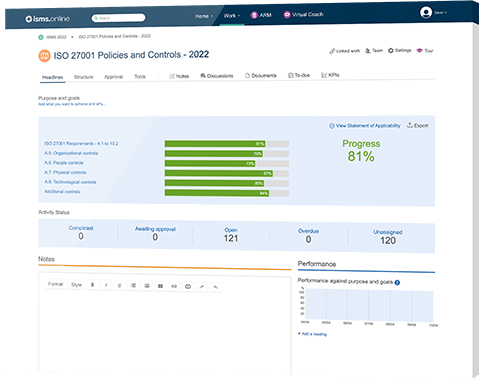
Logs – whether in the form of application logs, event logs or general system information – form a key part of obtaining a top-down view of ICT events and employee actions. Logs allow organisations to establish a timeline of events and scrutinise both logical and physical patterns across their entire network.
Producing clear and easily obtainable log information is an important part of an organisation’s overall ICT strategy, and accompanies numerous major information security controls contained within ISO 27002:2002.
Logs should:
Control 8.15 is a detective control that modifies risk by adopting an approach to logging that fulfils the above objectives.
| Control Type | Information Security Properties | Cybersecurity Concepts | Operational Capabilities | Security Domains |
|---|---|---|---|---|
| #Detective | #Confidentiality #Integrity #Availability | #Detect | #Information Security Event Management | #Protection #Defence |
Control 8.15 deals with ICT operations that are performed using system administrator access, and fall under the umbrella of network management and maintenance. As such, ownership of Control 8.15 should rest with the Head of IT, or organisational equivalent.
An ‘event’ is any action performed by a logical or physical presence on a computer system – e.g. a request for data, a remote login, an automatic system shutdown, a file deletion.
Control 8.15 specific that each individual event log should contain 5 main components, in order for it to fulfil its operational purpose:
For practical purposes, it may not be feasible to log every single event that occurs on a given network.
With that in mind, Control 8.15 identifies the below 10 events as being particularly important for logging purposes, given their ability to modify risk and the part they play in maintaining adequate levels of information security:
As explained in Control 8.17, it is vitally important that all logs are linked to the same synchronised time source (or set of courses), and in the case of third party application logs, any time discrepancies catered to and recorded.
Logs are the lowest common denominator for establishing user, system and application behaviour on a given network, especially when faced with an investigation.
It is therefore vitally important for organisations to ensure that users – regardless of their permission levels – do not retain the ability to delete or amend their own event logs.
Individual logs should be complete, accurate and protected against any unauthorised changes or operational problems, including:
ISO recommends that, in order to improve information security, logs should be protected using the following methods:
Organisations may need to send logs to vendors to resolve incidents and faults. Should this need arise, logs should be ‘de-identified’ (see Control 8.11) and the following information should be masked:
In addition to this, measures should be taken to safeguard personally identifiable information (PII) in line with the organisation’s own data privacy protocols, and any prevailing legislation (see Control 5.34).
When analysing logs for the purposes of identifying, resolving and analysing information security events – with the end goal of preventing future occurrences – the following factors need to be taken into account:

We’ll give you an 81% headstart
from the moment you log in
Book your demo
Log analysis should not be carried out in isolation, and should be done in tandem with rigorous monitoring activities that pinpoint key patterns and anomalous behaviour.
In order to achieve a dual-fronted approach, organisations should:
Organisations should consider using specialised utility programs that help them search through the vast amounts of information that system logs generate, in order to save time and resources when investigating security incidents, such as a SIEM tool.
If an organisation uses a cloud-based platform to carry out any part of their operation, log management should be considered as a shared responsibility between the service provider and the organisation themselves.
ISO 27002:2002-8.15 replaces three controls from ISO 27002:2003 that deal with the storage, management and analysis of log files:
27002:2002-8.15 largely corroborates all the guidance points from the above three controls into one clear protocol that deals with logging, with a few notable expansions, including (but not limited to):
The ISMS.Online platform helps with all aspects of implementing ISO 27002, from managing risk assessment activities through to developing policies, procedures and guidelines for complying with the standard’s requirements.
With its automated toolset, ISMS.Online makes it easy for organisations to demonstrate compliance with the ISO 27002 standard.
Contact us today to schedule a demo.
| ISO/IEC 27002:2022 Control Identifier | ISO/IEC 27002:2013 Control Identifier | Control Name |
|---|---|---|
| 5.7 | New | Threat intelligence |
| 5.23 | New | Information security for use of cloud services |
| 5.30 | New | ICT readiness for business continuity |
| 7.4 | New | Physical security monitoring |
| 8.9 | New | Configuration management |
| 8.10 | New | Information deletion |
| 8.11 | New | Data masking |
| 8.12 | New | Data leakage prevention |
| 8.16 | New | Monitoring activities |
| 8.23 | New | Web filtering |
| 8.28 | New | Secure coding |
| ISO/IEC 27002:2022 Control Identifier | ISO/IEC 27002:2013 Control Identifier | Control Name |
|---|---|---|
| 6.1 | 07.1.1 | Screening |
| 6.2 | 07.1.2 | Terms and conditions of employment |
| 6.3 | 07.2.2 | Information security awareness, education and training |
| 6.4 | 07.2.3 | Disciplinary process |
| 6.5 | 07.3.1 | Responsibilities after termination or change of employment |
| 6.6 | 13.2.4 | Confidentiality or non-disclosure agreements |
| 6.7 | 06.2.2 | Remote working |
| 6.8 | 16.1.2, 16.1.3 | Information security event reporting |
| ISO/IEC 27002:2022 Control Identifier | ISO/IEC 27002:2013 Control Identifier | Control Name |
|---|---|---|
| 7.1 | 11.1.1 | Physical security perimeters |
| 7.2 | 11.1.2, 11.1.6 | Physical entry |
| 7.3 | 11.1.3 | Securing offices, rooms and facilities |
| 7.4 | New | Physical security monitoring |
| 7.5 | 11.1.4 | Protecting against physical and environmental threats |
| 7.6 | 11.1.5 | Working in secure areas |
| 7.7 | 11.2.9 | Clear desk and clear screen |
| 7.8 | 11.2.1 | Equipment siting and protection |
| 7.9 | 11.2.6 | Security of assets off-premises |
| 7.10 | 08.3.1, 08.3.2, 08.3.3, 11.2.5 | Storage media |
| 7.11 | 11.2.2 | Supporting utilities |
| 7.12 | 11.2.3 | Cabling security |
| 7.13 | 11.2.4 | Equipment maintenance |
| 7.14 | 11.2.7 | Secure disposal or re-use of equipment |